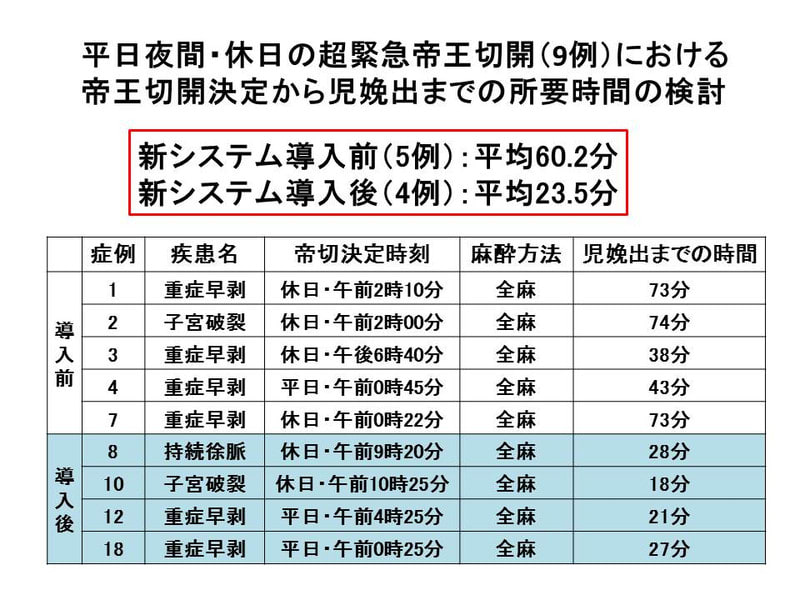第63回日本産科婦人科学会学術講演会 一般演題抄録
【演題名】 平日夜間および休日における超緊急帝王切開への取り組み
【目的】 当院では、平日夜間および休日(時間外)の緊急手術は自宅待機の手術室スタッフを招集して実施している。そのため、時間外では超緊急帝王切開であっても帝切決定から児娩出までに1時間以上かかる例も少なくなかった。そこで、時間外において超緊急帝切の準備が短時間にでき児を安全に娩出するために、院内にいるスタッフを緊急招集して手術を開始するシステム(新システム)を構築し、定期的にシミュレーションによるトレーニングを実施している。新システムの実績について報告する。
【方法】 2003年1月から2010年12月までの8年間に当院で分娩した6496症例の中で超緊急帝切となった症例について、頻度、適応、手術を実施した時間帯、帝切決定から児娩出までの時間などについて調査した。
【成績】 超緊急帝切は計18例で、施行率は0.28%(18/6496)、全帝切例の1.1%(18/1602)であった。適応は重症の常位胎盤早期剥:8例、重症の持続性胎児徐脈:7例、子宮破裂:2例、臍帯脱出:1例であった。麻酔方法別では、全身麻酔が16例、腰椎麻酔が2例であった。36週未満が6例、胎児発育不全が2例、陣痛促進中が2例、リトドリン点滴中が2例、時間外に実施した手術は9例であった。新システム導入後の時間外の超緊急帝切は4例で、いずれの症例でも帝切決定から児娩出までの時間は30分以内であった。
【結論】 当院における超緊急帝切は、関連各科の協力体制により、時間外でも帝切決定から概ね30分以内に児が娩出されている。超緊急帝切の適応疾患は分娩360例に1回の頻度で発生しており、その約半数は時間外に実施されている。各病院の事情に応じて、24時間体制で超緊急帝切に対応するための院内のシステムを整備しておく必要がある。
****** 英文抄録
A System for “Extremely Emergent Cesarean Section” (EECS) on Weekday Nights and Holidays (i.e., off business hours)
Dep. of Obs. & Gyn., Iida Municipal Hospital
YAMASAKI Teruyuki, HORISAWA Shin, MIYAMOTO Tsubasa, HURUKAWA Teppei, MATSUBARA Naoki, ASHIDA Takashi
Objectives: At our hospital, emergent surgery off business hours is carried out by operative staff members called from their homes. Under such a system, it was not uncommon that more than 1 hour elapsed from the decision to perform CS off business hours until delivery of the neonate, even in cases in which EECS was needed. To facilitate quick preparation for EECS and safe delivery of the neonate off business hours, we recently established a system for urgent calling of staff members from inside the hospital to perform EECS and have been periodically conducting simulation trainings based on this new system.
Methods: Of the 6496 women who delivered neonates at our hospital during the 8-year-period from January 2003 to December 2010, those who underwent EECS were investigated as to frequency, indications, time of the day that the operation was performed, time elapsed from the CS decision until delivery of the neonate.
Results: EECS was performed on 18 women, accounting for 0.28% of all women who delivered neonates at our hospital (18/6496) and 1.1% of all CS cases (18/1602). The reason for EEC was premature separation of normally implanted placenta in 8 cases, persistent fetal bradycardia in 7, uterine rupture in 2, and umbilical cord prolapse in 1. General anesthesia was applied in 16 cases and lumbar anesthesia in 2. Gestational age at surgery was less than 35 weeks in 6 cases. FGR had been noted before surgery in 2 cases. Two cases required operation while inducing labor, and 2 while receiving intravenous ritodrine hydrochloride. The operation was performed off business hours in 9 cases. After introduction of the new system, EECS off business hours was carried out on 4 cases, with the time elapsed from the CS decision until delivery of the neonate being 30 minutes or less in all 4 cases.
Conclusion: (1) At our hospital, EECS has been conducted with close linkage among relevant specialties, enabling completion of neonate delivery within 30 minutes after the decision to perform a CS even off business hours. (2) EECS has been needed at a frequency of 1 out of 360 deliveries, and about half of the cases underwent surgery off business hours. (3) It is desirable that each hospital providing obstetrical care establish a system tailored to its own circumstances to deal with the need for EECS on a 24-hour-per-day basis.

























